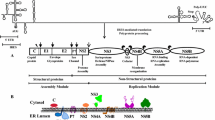Abstract
Early studies on hepatitis A virus (HAV) in cell culture demonstrated the inclusion of several viral particles in an intracellular lipid-bilayer membrane. However, the origin of these virus-associated membranes and the mechanism for the non-lytic release of HAV into bile are still unknown. Analyzing the association of this virus with cell organelles, we found that newly synthesized HAV particles accumulate in lysosomal organelles and that lysosomal enzymes are involved in the maturation cleavage of the virion. Furthermore, by inhibiting the processes of fusion of lysosomes with the plasma membrane, we found that the nonlytic release of HAV from infected cells occurs via lysosome-related organelles.



Similar content being viewed by others
References
Dotzauer A (2014) Hepatitis A virus. Ref Modul Biomed Sci. doi:10.1016/B978-0-12-801238-3.02581-2
Gust ID, Feinstone SM (1988) Hepatitis A. CRC Press, Boca Raton
Jecht M, Probst C, Gauss-Müller V (1998) Membrane permeability induced by hepatitis A virus proteins 2B and 2BC and proteolytic processing of HAV 2BC. Virology 252:218–227. doi:10.1006/viro.1998.9451
Teterina NL, Bienz K, Egger D et al (1997) Induction of intracellular membrane rearrangements by HAV proteins 2C and 2BC. Virology 237:66–77. doi:10.1006/viro.1997.8775
Morace G, Kusov Y, Dzagurov G et al (2008) The unique role of domain 2A of the hepatitis A virus precursor polypeptide P1-2A in viral morphogenesis. BMB Rep 41:678–683
Cohen L, Bénichou D, Martin A (2002) Analysis of deletion mutants indicates that the 2A polypeptide of hepatitis A virus participates in virion morphogenesis. J Virol 76:7495–7505
Shimizu YK, Shikata T, Beninger PR et al (1982) Detection of hepatitis A antigen in human liver. Infect Immun 36:320–324
Heinricy U, Stierhof Y-D, Pfisterer M, Flehmig B (1987) Properties of a hepatitis A virus candidate vaccine strain. J Gen Virol 68:2487–2493
Asher LVS, Binn LN, Marchwicki RH et al (1988) Electron microscopy and immunoelectron microscopy of hepatitis A virus in cell culture. Viral Hepat Liver Dis 1:19–23
Lemon SM, Binn LN (1985) Incomplete neutralization of hepatitis A virus in vitro due to lipid-associated virions. J Gen Virol 66:2501–2505
Feng Z, Hensley L, McKnight KL et al (2013) A pathogenic picornavirus acquires an envelope by hijacking cellular membranes. Nature 496:367–371. doi:10.1038/nature12029
Stewart SA, Dykxhoorn DM, Palliser D et al (2003) Lentivirus-delivered stable gene silencing by RNAi in primary cells. RNA 9:493–501
Cohen JI, Ticehurst JR, Purcell RH et al (1987) Complete nucleotide sequence of wild-type hepatitis A virus: comparison with different strains of hepatitis A virus and other picornaviruses. J Virol 61:50–59
Dotzauer A, Vallbracht A, Keil GM (1995) The proposed gene for VP1 of HAV encodes for a larger protein than that observed in HAV-infected cells and virions. Virology 213:671–675
Voeltz GK, Barr FA, Marks MS et al (2013) Lysosome-related organelles: unusual compartments become mainstream. Curr Opin Cell Biol 25:495–505
Schulman AN, Dienstag JL, Jackson DR et al (1976) Hepatitis A antigen particles in liver, bile, and stool of chimpanzees. J Infect Dis 134:80–84
Feinstone SM, Kapikian AZ, Purcell RH (1973) Hepatitis A: detection by immune electron microscopy of a viruslike antigen associated with acute illness. Science 182:1026–1028
Graham J, Ford T, Rickwood D (1994) The preparation of subcellular organelles from mouse liver in self-generated gradients of iodixanol. Anal Biochem 220:367–373. doi:10.1006/abio.1994.1351
Della Valle MC, Sleat DE, Zheng H et al (2011) Classification of subcellular location by comparative proteomic analysis of native and density-shifted lysosomes. Mol Cell Proteomics 10(M110):006403. doi:10.1074/mcp.M110.006403
Siegl G, Weitz M, Kronauer G (1984) Stability of hepatitis A virus. Intervirology 22:218–226
De Duve C, De Barsy T, Poole B et al (1974) Lysosomotropic agents. Biochem Pharmacol 23:2495–2531. doi:10.1016/0006-2952(74)90174-9
Yoon YH, Cho KS, Hwang JJ et al (2010) Induction of lysosomal dilatation, arrested autophagy, and cell death by chloroquine in cultured ARPE-19 cells. Invest Ophthalmol Vis Sci 51:6030–6037. doi:10.1167/iovs.10-5278
Blott EJ, Griffiths GM (2002) Secretory lysosomes. Nat Rev Mol Cell Biol 3:122–131. doi:10.1038/nrm732
Luzio JP, Pryor PR, Bright NA (2007) Lysosomes: fusion and function. Nat Rev Mol Cell Biol 8:622–632. doi:10.1038/nrm2217
Cerny J, Feng Y, Yu A et al (2004) The small chemical vacuolin-1 inhibits Ca(2+)-dependent lysosomal exocytosis but not cell resealing. EMBO Rep 5:883–888. doi:10.1038/sj.embor.7400243
Liu Y, Zhou Y, Zhu K (2012) Inhibition of glioma cell lysosome exocytosis inhibits glioma invasion. PLoS One 7:e45910. doi:10.1371/journal.pone.0045910
Lu Y, Dong S, Hao B et al (2014) Vacuolin-1 potently and reversibly inhibits autophagosome-lysosome fusion by activating RAB5A. Autophagy 10:1895–1905. doi:10.4161/auto.32200
Chang Y-C, Nalbant P, Birkenfeld J et al (2008) GEF-H1 couples nocodazole-induced microtubule disassembly to cell contractility via RhoA. Mol Biol Cell 19:2147–2153. doi:10.1091/mbc.E07-12-1269
Gravotta D, Carvajal-Gonzalez JM, Mattera R et al (2012) The clathrin adaptor AP-1A mediates basolateral polarity. Dev Cell 22:811–823. doi:10.1016/j.devcel.2012.02.004
Kowal J, Tkach M, Théry C (2014) Biogenesis and secretion of exosomes. Curr Opin Cell Biol 29C:116–125. doi:10.1016/j.ceb.2014.05.004
Acknowledgments
We thank Mediagnost, Reutlingen, Germany, for providing the mAb anti-HAV IgG 7E7. This work was supported by grant BFK-no. 02/803/08 of the University of Bremen, Bremen, Germany, and by the Tönjes-Vagt-Stiftung, Project XXIX, Bremen, Germany.
Author information
Authors and Affiliations
Corresponding author
Rights and permissions
About this article
Cite this article
Seggewiß, N., Paulmann, D. & Dotzauer, A. Lysosomes serve as a platform for hepatitis A virus particle maturation and nonlytic release. Arch Virol 161, 43–52 (2016). https://doi.org/10.1007/s00705-015-2634-5
Received:
Accepted:
Published:
Issue Date:
DOI: https://doi.org/10.1007/s00705-015-2634-5




